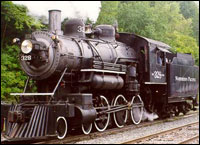
|
|
The Wabash Cannonball
The original Wabash Cannonball of the Wabash Railroad was built in the 1880s. It was lit by oil lamps and heated by potbellied stoves. It has been reported to have been a Chicago to Kansas City train, others say St. Louis to Omaha, or between Detroit and Kansas City. Soon after the turn of the century the name was removed from the Wabash timetables and did not reappear until 1950, when a streamlined lightweight diesel Wabash Cannonball started its run between Detroit and St. Louis.
In 1964, the Wabash Railroad merged with Norfolk and Western, and the train's name was changed to the Cannonball, but a public outcry forced the restoration of the full name. Beginning in 1967, and annually thereafter, Norfolk and Western petitioned the ICC for permission to discontinue the Wabash Cannonball, but it ran until May 1, 1971, when Amtrak took over all intercity rail passenger service.
|
|
|

This train is still in service. Visit Minnesota Transportation Museum for more information.
The old-time 10-wheeler, 4-6-0, was popular in American railroading around the turn of the century. 4-6-0 refers to the wheels on the locomotive: 4 small wheels in front and 6 large wheels joined up behind. Sometimes there was another set of small wheels, but not on this model (thus the -0 at the end).
|
|
|
|
Changing Roles for Trains
Trains have a special place in Western history. Intimately connected to the industrial growth of the US and Europe, they've symbolized power and plenty.
Today, trains have a more ambivalent image. Other nations' bullet trains haven't made it to the US, where a heavily subsidized rail system has lost commercial users to trucking and personal-travel users to airlines.
Action movies may still show stirring scenes on trains, but subways and interurban light rail are the more relevant people movers. The elegance of the dining and sleeper cars of the mid-20th century is gone.
|
|
|